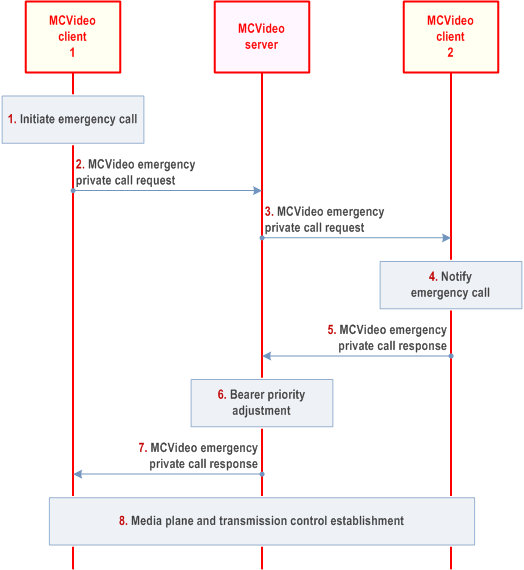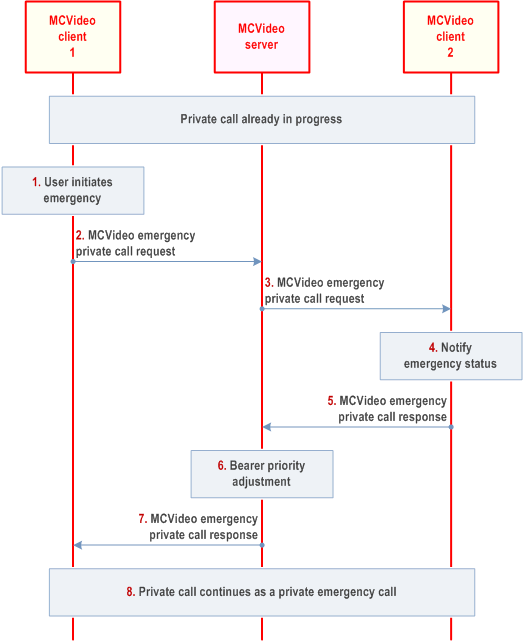Content for TS 23.281 Word version: 19.1.0
1…
5…
6…
7…
7.1.2.3…
7.1.2.3.1.2…
7.1.2.3.2…
7.1.2.4…
7.1.2.5.2…
7.1.3…
7.2…
7.2.2.3…
7.2.2.4…
7.2.3…
7.3…
7.4…
7.4.3…
7.5…
7.5.2.3…
7.6…
7.7…
7.7.1.3…
7.7.1.3.2A…
7.7.1.3.4…
7.7.1.3.6…
7.7.2…
7.7.2.7…
7.7.2.9…
7.8…
7.11…
7.17…
7.19…
7.19.2.8…
7.19.3…
7.19.3.1.4…
7.19.3.2…
7.19.3.2.3…
7.19.3.2.6…
A…
7.2.2.4 MCVideo emergency private call
7.2.2.4.1 MCVideo emergency private call commencement
7.2.2.4.2 MCVideo private call emergency upgrade
...
...
7.2.2.4 MCVideo emergency private call |R15| p. 77
7.2.2.4.1 MCVideo emergency private call commencement p. 77
This procedure describes the case where an authorized MCVideo user is initiating an MCVideo emergency private call with unicast signalling for communicating with another MCVideo user. An MCVideo client in the MCVideo emergency state gains elevated access privilege for all of the MCVideo user's mission critical applications.
Procedures in Figure 7.2.2.4.1-1 are the procedures for the MCVideo client initiating establishment of an MCVideo emergency private call.
Pre-conditions:
- Both members of the MCVideo private call belong to the same MCVideo system.
- The initiating MCVideo client 1 has been configured to send an MCVideo emergency alert prior to initiating an MCVideo emergency private call.
- Optionally, the MCVideo client 1 may have a functional alias activated to be used.
- The MCVideo server may have subscribed to the MCVideo functional alias controlling server within the MC system for functional alias activation/de-activation updates.

Step 1.
The user at the MCVideo client 1 initiates an MCVideo emergency private call. MCVideo client 1 sets its MCVideo emergency state. MCVideo client 1 retains the MCVideo emergency state until explicitly cancelled by the user of MCVideo client 1.
Step 2.
MCVideo client 1 sends an MCVideo emergency private call request towards the MCVideo server. The request contains an indication of the MCVideo emergency. The MCVideo user at MCVideo client 1 may include a functional alias used within the MCVideo emergency private call. The MCVideo server verifies whether the provided functional alias can be used. The MCVideo server records the identity of the MCVideo user that initiated the MCVideo emergency private call until the MCVideo emergency is cancelled. If the MCVideo client is configured to send an MCVideo emergency alert when initiating an MCVideo emergency private call, the request also contains an indication that an MCVideo emergency alert is to be initiated.
Step 3.
MCVideo server sends the MCVideo emergency private call request towards the target MCVideo client. The request contains an indication of the in-progress emergency. The request contains an indication of an MCVideo emergency alert if the request from the originator indicated MCVideo emergency alert. If available the request contains the functional alias of the calling MCVideo user 1.
Step 4.
The MCVideo user on MCVideo client 2 is notified of the incoming MCVideo emergency private call. If the functional alias of the calling user is included it is displayed.
Step 5.
The receiving MCVideo client acknowledges the MCVideo emergency private call request to the MCVideo server via a MCVideo emergency private call response.
Step 6.
The MCVideo server adjusts the priority of the underlying bearer.
Step 7.
The MCVideo server informs MCVideo client 1 about the successful MCVideo emergency private call establishment via a MCVideo emergency private call response.
Step 8.
MCVideo client 1 and MCVideo client 2 establish the media plane and transmission control for video communication.
7.2.2.4.2 MCVideo private call emergency upgrade p. 79
This procedure describes the case where an authorized MCVideo user is upgrading a private call to an MCVideo emergency private call while the private call is already in progress.
Procedures in Figure 7.2.2.4.2-1 are the signalling procedures for the MCVideo client upgrading a private call to an MCVideo emergency private call.
Pre-conditions:
- Both members of the private call belong to the same MCVideo system.
- A private call is already in progress.

Step 1.
The MCVideo user at MCVideo client 1 initiates an emergency. MCVideo client 1 sets its MCVideo emergency state. MCVideo client 1 retains the MCVideo emergency state until explicitly cancelled by the user of MCVideo client 1.
Step 2.
MCVideo client 1 requests the MCVideo server to upgrade the private call to in-progress emergency by sending an MCVideo emergency private call request. If configured to send an MCVideo alert when initiating an MCVideo emergency upgrade, the request also contains an indication that an MCVideo alert is to be initiated. The request may contain an indication of an implicit transmit media request.
Step 3.
MCVideo server sends the MCVideo emergency request towards MCVideo client 2, the MCVideo client of the other participant.
Step 4.
The MCVideo user of MCVideo client 2 is notified of the in-progress emergency of the MCVideo emergency private call.
Step 5.
The receiving MCVideo client acknowledges the MCVideo emergency request to the MCVideo server.
Step 6.
The MCVideo server adjusts the priority of the underlying bearer for both participants in the private call. The priority is retained until the call ends.
Step 7.
The MCVideo server confirms the upgrade request to MCVideo client 1. If the MCVideo emergency request contained an implicit transmit media request, the MCVideo emergency private call response message contains the result of the implicit transmit media request.
Step 8.
MCVideo client 1 and MCVideo client 2 continue with the private call, which has been transformed into an MCVideo emergency private call. MCVideo client 1 can override MCVideo client 2 unless MCVideo client 2 is also in the MCVideo emergency state.